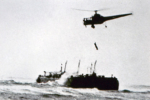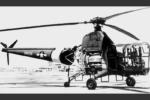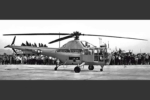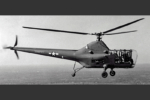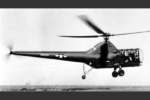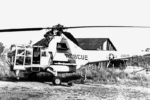Sikorsky Product History
Sikorsky S-48 / VS-327
Background
The Sikorsky S-48/VS-327/R-5 model was a follow-on to the successful R-4 helicopter. It was designed to meet a 1942 U.S. Army Air Forces (USAAF) requirement for a larger more capable observation helicopter as well as a British requirement. The XR-5 helicopters featured a 48 foot 3 bladed fully articulated main rotor and a 3 bladed tail rotor powered by the reliable Pratt and Whitney 450 hp R985-AN-5 radial engine. The S-48 had a 2 place tandem cockpit with the observer in the forward position and the pilot aft. Four Experimental XR-5 helicopters were initially built with a fifth XR-5A ordered later. The first flight was on August 18, 1943.
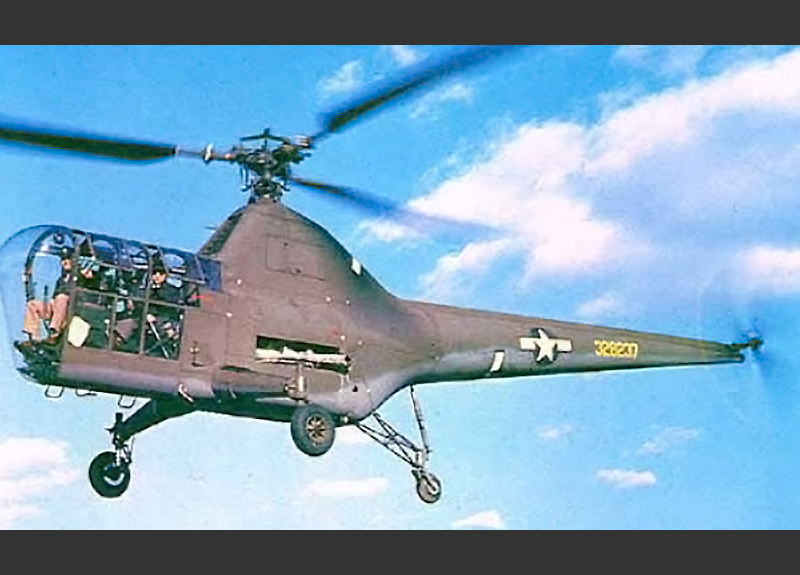 Sikorsky S-48/XR-5 Army Serial No. 43-28237
Sikorsky S-48/XR-5 Army Serial No. 43-28237 YR-5A hovering with 10 passengers and 2 crewmen.
YR-5A hovering with 10 passengers and 2 crewmen. First Civilian Rescue, Penfield Reef, Fairfield, Connecticut
First Civilian Rescue, Penfield Reef, Fairfield, Connecticut YR-5A Army Serial no. 43-46624 with panels removed shows construction details.
YR-5A Army Serial no. 43-46624 with panels removed shows construction details. R-5D (H-5D) being introduced in Hawaii 1947
R-5D (H-5D) being introduced in Hawaii 1947 S-48 XR-5 Army Serial No.43-28237 in flight.
S-48 XR-5 Army Serial No.43-28237 in flight. YR-5E Army Serial No. 43-46611 with dual controls for flight training.
YR-5E Army Serial No. 43-46611 with dual controls for flight training. R-5D Army Serial no. 43-46646 in Nicaragua in May 1947.
R-5D Army Serial no. 43-46646 in Nicaragua in May 1947.
The successful testing of the five Experimental XR-5 helicopters resulted in a USAAF order for 26 YR-5A developmental helicopters for service testing in March 1944. A follow-on production contract from the USAAF for 100 R-5D rescue configured helicopters was received in 1944 but only 34 were actually built. The end of World War II resulted in the cancellation/curtailment of many contracts.
In 1945, a demonstration of the capabilities of the XR-5 was done by Sikorsky test pilot Les Morris picking up 10 people weighing over 2,000 lbs into a hover with the ladies of Sikorsky cheering them on. The link below is Paramount New coverage of the event.
The first civilian rescue by a helicopter was accomplished on November 29, 1945 by a YH-5A helicopter flown by Sikorsky chief pilot Jimmy Viner and assisted by U. S. Army Capt. Jack Beighle. The YR-5A rescued a captain and his crewman from a barge aground in a storm on Penfield Reef, Fairfield Connecticut. Penfield Reef is located just offshore from the Sikorsky Bridgeport Connecticut plant. The complete story of this historic rescue is found in the Sikorsky Historical Archives article The First Civilian Rescue.
S-48/VS-327 Development Timeline
Contract Award
First Flight
Max Gross Weight Test
Unofficial Speed Record Set
Unofficial Altitude Record Set
First Delivery
Operation Mail
Configuration Features
The Sikorsky XR-5 fuselage was built in 3 sections: an aluminum framed cabin with plexiglass windows and tandem seating for 2; a steel frame center section was covered with plastic impregnated plywood panels, and the tail cone was a wood monocoque design.
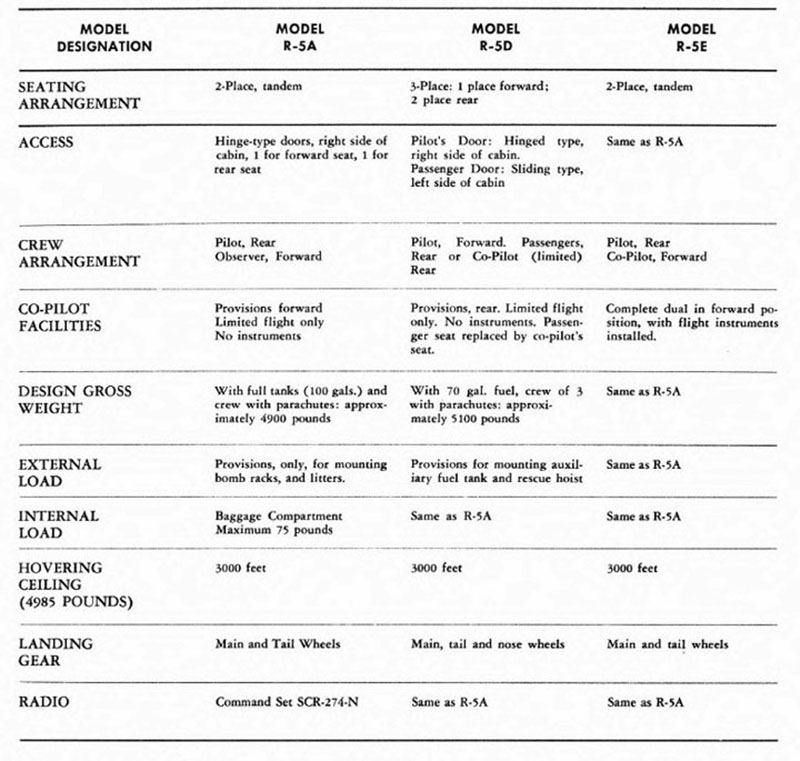
The YR-5A helicopters were modified to several different configurations during their years of service. The configuration differences are listed below. Five YR-5A helicopters were modified to the YR-5E configuration with dual flight controls for pilot training. The R-5D had a wider cabin with the pilot moved forward and a 2 place bench seat in the rear. Provisions for a rescue hoist and an auxiliary fuel tank were added. In June, 1948, the U.S.Air Force helicopter designations were changed from R to H. The Air Force Rescue service operated H-5D, H-5F, H-5G, and H-5H helicopters. The only problem was that the F, G, and H models were S-51 models. The only S-48 model operated by the Air Force is easily identified by having both a small nose wheel and a tail wheel. This has caused numerous errors in history write-ups and picture identification.
The RTAF Museum in Bangkok has H-5A and H-5F helicopters on display side by side which clearly shows the differences between the 2 models.

Main Rotor Assembly
A 3 blade fully articulated main rotor head was installed on the S-48 helicopter. The rotor diameter was 48 feet.
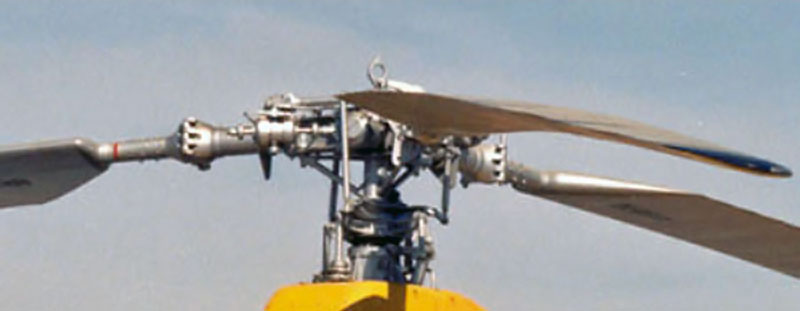
Main Rotor Control
The main rotor head controls were located around the main gear box. They consisted of three jackscrews and the chain system to actuate them. The jack, in turn, actuated the azimuth star (swashplate). The three jacks when operated in unison through manipulation of the Collective Pitch Control Stick raise the star to increase the pitch of the three rotor blades, lower the star to decrease the pitch. Fore-and Aft cyclic control was accomplished by the differential motion of the fore-and aft jacks, which tilt the azimuth star forward or backward. Sideways control was accomplished by raising or lowering the right jackscrew only, which tilted the azimuth laterally to one side or the other.
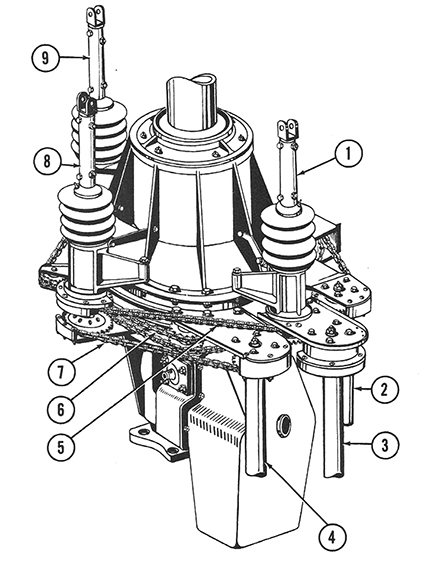
- Forward Jackscrew
- Collective Pitch Sprocket Shaft
- Cyclic Pitch Fore-and-Aft Sprocket Shaft
- Cyclic Pitch Lateral Sprocket Shaft
- Collective Pitch Chain
- Cyclic Pitch Fore-and-Aft Chain
- Cyclic Pitch Lateral Chain
- Right Jackscrew
- Rear Jackscrew
Engine
A Pratt and Whitney Wasp Jr. 450 hp R-985 AN-5 engine was installed horizontally under the center section of the helicopter with a cooling fan/flywheel above. A centrifugal clutch connected the engine to the transmission. The throttle control was located on the main pitch control lever (Collective) and was synchronized to increase the throttle when pitch was increased and decreased when pitch was decreased.
Main Rotor Blades
The main rotor blades were constructed with wood spars, plywood ribs and leading edge, canvas covered pockets, and a NACA 0012 airfoil.
Tail Rotor
A semi-articulated tail rotor with 3 blades was installed. Blades were constructed of laminated wood.
General Arrangement Drawing
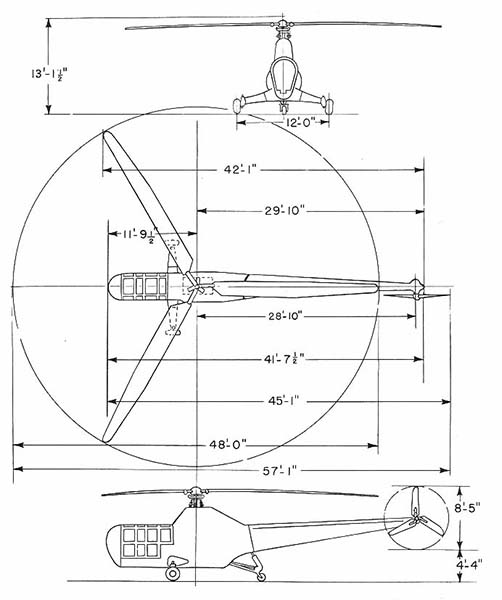
Mission Systems
The tactical mission of the S-48 helicopter was for observation and assisting the artillery by locating suitable targets and adjusting fire.
Two XR-5A helicopters were provided to the British Air Commission for trials aboard ship to determine if they could assist in combating the submarine menace.
The R-5D helicopter was equipped with a rescue hoist and an auxiliary fuel tank and was the first helicopter assigned to the USAAF/USAF Air Rescue Service.
General Characteristics and Performance S-48 (R-5)
PERFORMANCE
Standard Day, Sea Level
| Maximum speed (Vne) | 107 kts 198 km/hr. |
Range | 275 miles 442.6km |
Service ceiling | 14,800 ft 4,511 m |
Rate of Climb | 2,000 ft/min 10.1 m/s |
Absolute hover ceiling | 3,000 ft 914.4 m |
WEIGHTS
Maximum takeoff gross weight | |
R-5A | 4,900 lbs 2,222.6 kg |
R-5D | 5,100 lbs 2,313,3 kg |
R-5E | 4,,985 lbs 2,261.2 kg |
Weight empty | 3,780 lbs 1,714,6 kg |
Maximum fuel load | |
R-5A | 100 gal 378.5 ltr |
R-5D | 71 gal 268.8 ltr |
R-5E | 64 gal 242.3 ltr |
GENERAL DATA
Crew seating capacity | 2 |
Seating capacity (R-5D) | 2 passengers |
POWERPLANT RATINGS
Standard Day at Sea Level
| Pratt and Whitney R985 AN-5 | 450 hp 335 kw |
AIRCRAFT DIMENSIONS
Main rotor diameter (blade tip circle) | 48’ 0” 14.63 m |
Tail rotor diameter (blade tip circle) | 8’ 5”” 2.44 m |
Fuselage length | 41’7.5″ 12.5m |
Length over-all (including rotors) | 57’1″ 17.4 m |
Height over-all | 13’ 1.5” 4 m |
Main landing gear tread | 12′ 0″ 3.7 m |
Production History
S-48 (R-5) production consisted of 65 helicopters:
- 5 XR-5 models manufactured from August 1944 to November 1944
- 26 YR-5A models manufactured from November 1944 to July 1945
- 14 R-5A and 20 R-5D models manufactured from July 1945 to October 1946.
Additional Information
The S-48 (R-5) was replaced by the more capable S-51 helicopter which addressed many of the lessons learned from the S-48 program.
- by Vinny Devine
Related Articles
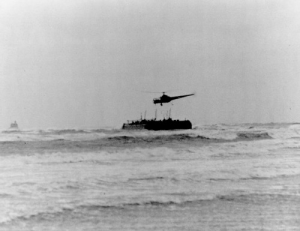
The World’s First Helicopter Civilian Rescue
On November 29, 1945 in Fairfield Connecticut, a Sikorsky R-5 performed the first helicopter hoist rescues in aviation history.

Sikorsky Helicopters in U.S. Air Force Rescue Squadrons
The HH-60W Combat Rescue Helicopter is the latest in the life-saving line of Sikorsky helicopters made for U.S. Air Force Rescue Squadrons. The Whiskey will round out a century of vertical flight rescue heroism.
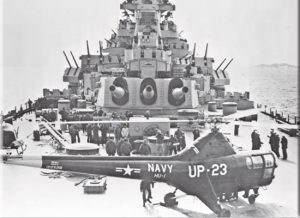
Sikorsky Helicopters Came of Age in the Korean War
Prior to the Korean War, the U.S. armed forces had few helicopters and little combat helicopter doctrine. The Korean conflict drove rapid combat helicopter development.
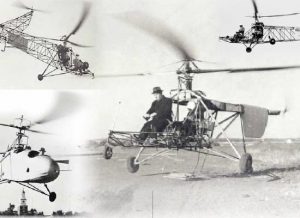
75th Anniversary of the S-46 (VS-300)
During this period, Sikorsky Aircraft designed, developed, and produced the S-47 (R-4), S-48 (S-5), S-49 (R-6), S-51, S-52, and S-55 helicopters.



